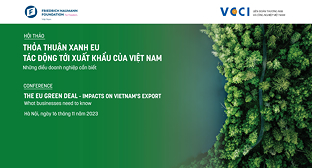EU acknowledges Vietnam’s achievements on export diversification & competitiveness via partial GPS
18/06/2008 12:00
“The review of our Generalised System of Preferences (i.e., the preferential tariffs for the poorest countries) has confirmed
The EU remains willing to offer
The Generalised System of Preferences (GSP) was created in 1971 with a view to fostering development through trade by providing developing countries with unilateral tariff preferences and a duty free/quota free regime to Least-Developed countries.
First, if GSP-covered imports of a good (e.g., textiles) from one country represent 15% of all imports into the EU of that good from all GSP beneficiaries, that country's sector is so competitive that does not need preferential treatment anymore – this is called graduation.
Second, in order to encourage diversification and not penalise over-dependency, the EU GSP regime foresees that sectors that meet the 15 % threshold shall continue enjoying GSP benefits if they constitute at least 50 % of all GSP imports originating from the country in question. This clause was created in 2005, to accommodate
Based on the 2004-2006 data (GSP figures), the EU has conducted its review of the GSP regime and the Council approved on 11 June a new GSP regulation for the period 2008-2010.
The review, which covers all countries and is based on comparable statistical data provided by Eurostat, acknowledged the success of
2007 figures confirm this tendency, with a further 10% increase in textiles bringing total Vietnamese textile exports to the EU to EUR 1.16 billion. Other big products such as coffee, exports of which increased by 36% in 2007 to reach some EUR 834 million.
The GSP review also confirms that the Vietnamese footwear sector is one of the most competitive worldwide. Total Vietnamese footwear exports to the EU in 2007 grew over 20% from 2004 to 2006 and, in 2007, by a further 10.6%.
Exports to the EU have only been marginally affected by anti-dumping duties, as such duties only apply to 20% of
Experience from other countries shows that the graduation mechanism truly responds to the competitiveness of the sector going forward: the footwear sector in China, for example, continued to grow after the GSP benefits had been removed (and in spite of being subject to anti-dumping duties 6.5 points higher than Vietnam): between 2004 and 2006, China managed to enhance its share of footwear exports to the EU from 42.7 to 55.2%.
The Vietnamese footwear industry shows similar signs of strength, with some 20% of shoes exported to the EU not even claiming GSP benefits: This suggests that a growing number of shoe exporters are able to sell at competitive prices in the EU market without any privileges but rather leveraging on other vectors such as quality and branding.
The European Commission also pledged to continue supporting
Last updated: 17:3 -
Source: www.nhandan.com.vn
Các tin khác
- Exports face challenges despite enjoying robust growth (26/04/2024)
- Vietnam ranks fifth among aquatic product suppliers for Singapore (26/04/2024)
- Some firms likely to close due to higher anti-dumping tariff on plywood products in S Korea (26/04/2024)
- Foreign businesses increasingly seek export sources in Vietnam (26/04/2024)
- Japan's investigation into China's graphite electrodes to 'affect regional cooperation' (26/04/2024)
 Home
Home
 About Us
About Us




















